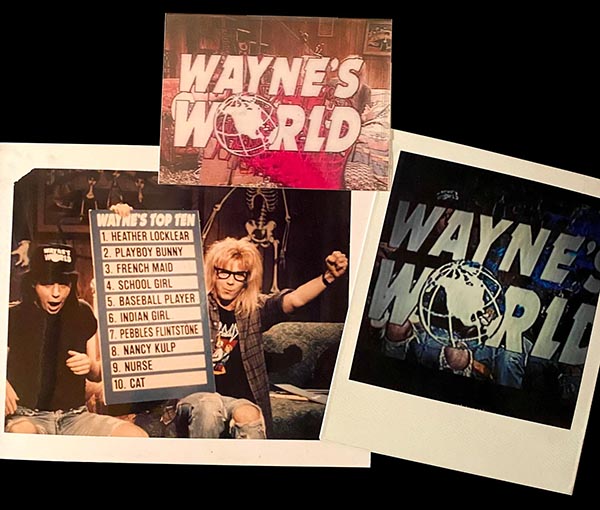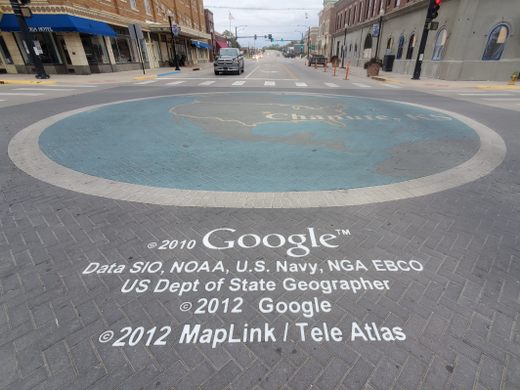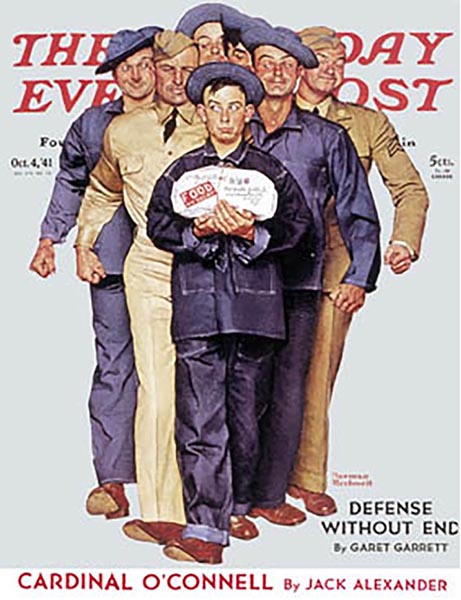
Live from New York…It’s Graphic Design!
Believe it or not, this year marks the 50th anniversary of Saturday Night Live. Although we have not seen it in literally decades, aside from the occasional clip here and there, Print magazine talks to Marlene Weisman, an in-house graphic designer for the show for seven seasons (1988–1994). She reminisces about the pre-computer graphics production process.
in-house at our creative disposal we had sheets and sheets of Letraset, an in-house phototypesetting machine, a vinyl lettering machine, a huge room-sized stat camera, paste-up and drawing art supplies, and the ability to fabricate 3M custom transfers for props. It was all there—a wonderland of an art department!
… We didn’t get Macs in our art department until the mid-’90s, and when we finally got one, it went into an office deemed “the Computer Room.” That Mac was not yet even connected with the show’s control room—what a long way we’ve come since then!

Fun fact: I chose the “cheesy” font (available on our art department’s vinyl lettering machine) for the Wayne’s World logo. Pook said “italicize it,” and I can’t recall which of us added the globe. Who could know it would become the global phenomenon it became as the years rolled on?
Alas, Poor Yorke
This is…interesting. Via Deadline, Radiohead singer Thom Yorke is working with the Royal Shakespeare Theatre for a new production of William Shakespeare's Hamlet— based on Radiohead’s 2003 album Hail To The Thief, called Hamlet Hail To The Thief. OK, the title could be a vague reference to Claudius, who (spoiler alert) killed Hamlet’s father and usurped the throne. But aside from that?
Described as a “fast-paced distillation” of the play, producers have said Shakespeare’s words and Radiohead’s album “illuminate one another” as Radiohead’s music becomes a central part of the play’s narrative. The play is said to have been “personally reworked by Yorke.” The music will be performed live onstage by a cast of 20 musicians and actors.
…“This is an interesting and intimidating challenge,” Yorke said of the production. “Adapting the original music of Hail To The Thief for live performance with the actors on stage to tell this story that is forever being told, using its familiarity and sounds, pulling them into and out of context, seeing what chimes with the underlying grief and paranoia of Hamlet, using the music as a ‘presence’ in the room, watching how it collides with the action and the text. Ghosting one against the other.”
The production will run from April 27–May 18, 2025, at Aviva Studios in Manchester before moving to the Royal Shakespeare Theatre in Stratford, where it will run from June 4–28, 2025.
Virginia Vision
It’s leaf-peeping season, that time of year when fall foliage fanatics travel to watch the trees turn color. One group that misses out on leaf-peeping are those with color-vision deficiency (aka color blindness). But, via Mental Floss, Virginia is taking the lead on helping bring the full foliage spectrum to people with the condition. The state has installed color blind-friendly viewfinders in all 43 state parks.
The devices use special lenses from the brand EnChroma to help colorblind people differentiate between shades. In eyes that work properly, light wavelengths stimulate the color pigments in the retina’s cones. This process activates different sensations in the brain and allows people to see a variety of hues. When an individual’s cones don’t work properly, their color perception is limited, causing vision impairment or blindness. The most common type of color blindness comes from an excessive overlap of the green- and red-perceiving cones. This results in the otherwise distinct colors becoming impossible to distinguish.
The viewfinders are specific to people with red-green color deficiency. And people who do not have color vision deficiency can also use the viewfinders—they’ll see especially vibrant autumn colors.
Journey to the Center of Google Earth
Here’s a question that astrophysicists can ponder: where is the center of the universe? Actually, the question is probably moot; if the universe is indeed infinite, there would be no center…or just about anywhere could be so designated. As in fact a couple of Google engineers did. Via Atlas Obscura, Brian McClendon, the co-founder of the company that became the basis of Google Earth, is a native of Lawrence, Kan., and set the default location on the PC version of Google Earth to the coordinates of his childhood home—not without some justification, as it is actually pretty close to the actual geographic center of the continental United States. Meanwhile, another engineer, Dan Webb, working on the Mac version set the default location to his hometown of Chanute, Kan. The town of Chanute, however, let this go to its head.
In 2010, the Chanute Area Chamber of Commerce commissioned a mural of the Google Earth display on Mac computers, and installed it in the center of the town’s busiest intersection. The map includes an outline of the United States of America, a giant star with Chanute, Kansas highlighted in the center, and a copyright verifying the screenshot.


Google Earth no longer defaults to any single location (except for, well, Earth) but the mural still exists.
From the Earth to the Moon:
In the Moon Time
Better update your calendar app, because NASA has just announced that the Moon is getting its own time zone, to be called Coordinated Lunar Time (LTC). Says Newsweek:
Led by NASA’s Space Communication and Navigation (SCaN) program, the initiative could eventually extend to other celestial bodies across the solar system. As humanity prepares to return to the Moon, LTC will be essential in developing a sustainable lunar ecosystem and ensuring the safety of future missions.
It's apparently not as simple as just saying “OK, if it’s noon in New York it’s 9pm on trhe Moon.”
Similar to Earth's Coordinated Universal Time (UTC), the lunar time will be calculated using a weighted average of atomic clocks placed on the Moon.
But:
However, establishing LTC isn't without its challenges. For one thing, accounting for the effects of Einstein's theories of special and general relativity is a tricky business. Current analysis shows that atomic clocks on the lunar surface appear to tick faster by microseconds per day due to differences in gravitational effects.
So if you had one clock on Earth and another on the Moon, after 24 Earth hours, the Moon clock will be ahead by about 56 microseconds. So people traveling from Earth will inevitably be late to meetings, like Zoom attendees. In the world of space travel, this is not insignificant.
"If someone is orbiting the Moon, an observer on Earth who isn't compensating for the effects of relativity over a day would think that the orbiting astronaut is approximately 168 football fields away from where the astronaut really is."
Insert your own Amtrak joke here.
The development of LTC is not just about the Moon. NASA envisions this timekeeping system as a stepping stone for future Mars missions and exploration of other parts of our solar system. By addressing the complexities of time in space now, NASA is laying the groundwork for long-duration exploration missions in the future.
We’re going to make LTC the default time zone for Google Calendar, just for fun.
Graphene Gets In your Head(set)
Was it a good week for graphene news? It’s always a good week for graphene news! A new headset with graphene-coated drivers. From (who else?) Graphene-Info:
Alienware debuted its Pro Mouse and Keyboard in January at CES 2024, and now the company is introducing the Pro Headset as part of the series. The headphones incorporate various technologies, including 50mm drivers that are coated with graphene to reduce distortion commonly found at higher frequencies.
A steal at $230.
Supercalendar
Do you like Lego? Advent calendars? If yes to both, then good news! Lego’s 2024 Advent calendars are now on sale. There are five available:
- Lego Star Wars
- Lego Spiderman
- Lego City
- Lego Disney
- Lego Friends
No, the latter is not the TV show Friends, with little Rosses or Phoebes behind the doors.

Says CNN:
Depending on which of the sets you decide on, you’ll find everything from miniature recreations of iconic Star Wars vehicles to recreations of iconic scenes from the Marvel Cinematic Universe, and even sweater-clad versions of signature characters like Luke Skywalker and Spider-Man. Plus, there are some other fun smaller inclusions that help you count down to the actual festivities at the end of December.
Available starting at $33 at Walmart or wherever fine Advent calendars are sold.
ReMarkable
Looking for a good, e-paper-based tablet that you can write on? Boing Boing highly recommends the ReMarkable Paper Pro.
Bring paper into your digital workflow with reMarkable Paper Pro. Ultra-slim and portable, but with a full-size 11.8" color display, adjustable reading light, and an unmatched paper-like writing experience. The textured surface of the custom-built display is crafted to deliver realistic friction and even more natural writing feel. Lightning-fast responsiveness and a pen-to-ink distance of less than 1 mm make reMarkable Paper Pro the peak of paper realism.

A steal at $579.
AI-Yi-Yi, Part the Infinity: There Is No AI
Yes, actually, according to a headline in The New Yorker, “There Is No A.I.” Cool. Well, that takes care of that. Next item…
OK, we should probably read on.
The term “artificial intelligence” has a long history—it was coined in the nineteen-fifties, in the early days of computers. More recently, computer scientists have grown up on movies like “The Terminator” and “The Matrix,” and on characters like Commander Data, from “Star Trek: The Next Generation.” These cultural touchstones have become an almost religious mythology in tech culture. It’s only natural that computer scientists long to create A.I. and realize a long-held dream.
It's a long piece, but at heart:
The most pragmatic position is to think of A.I. as a tool, not a creature. My attitude doesn’t eliminate the possibility of peril: however we think about it, we can still design and operate our new tech badly, in ways that can hurt us or even lead to our extinction. Mythologizing the technology only makes it more likely that we’ll fail to operate it well—and this kind of thinking limits our imaginations, tying them to yesterday’s dreams. We can work better under the assumption that there is no such thing as A.I. The sooner we understand this, the sooner we’ll start managing our new technology intelligently.
If the new tech isn’t true artificial intelligence, then what is it? In my view, the most accurate way to understand what we are building today is as an innovative form of social collaboration.
Cloaking De Mice
We’re not sure where to even begin with this headline from Ars Technica: “Mice made transparent with a dye used in Doritos.”
First of all, do we really need transparent mice? Second of all, reading on, it’s even more disturbing: it’s their skin that is transparent. Let’s back up and see what the premise of this is:
One key challenge in medical imaging is to look past skin and other tissue that are opaque to see internal organs and structures. This is the reason we need things like ultrasonography, magnetic resonance, or X-rays. There are chemical clearing agents that can make tissue transparent, like acrylamide or tetrahydrofuran, but they are almost never used in living organisms because they’re either highly toxic or can dissolve away essential biomolecules.
Those would be downsides, yes. So the breakthrough is that scientists have in fact been able to make a skin transparentizer that doesn’t actually damage the skin. And it’s based on tartrazine, a common yellow-orange food dye called FD&C Yellow 5—perhaps most notably used for coloring Doritos. (Yes, there’s probably a mice/nacho cheese joke to be made, but we’re not that transparent.)
“The most surprising part of this study is that we usually expect dye molecules to make things less transparent,” says Guosong Hong, an assistant professor of materials science and engineering at Stanford and senior author of the paper. “For example, if you mix blue pen ink in water, the more ink you add, the less light can pass through the water. However, in our experiment, when we dissolve tartrazine in an opaque material like muscle or skin, which normally scatters light, the more tartrazine we add, the clearer the material becomes. This goes against what we typically expect with dyes.”
So you shouldn’t rub Doritos on your skin? Ah, no: they created a transparency-inducing lotion. Come on, they’re not calling it vanishing cream? (Do they still make vanishing cream? )
The “transparency lotion” needed just a few minutes to start working when applied to a mouse’s skin. Massaged into a shaven scalp, it lets the scientists see the cerebral blood vessels with laser speckle contrast imaging, a technique that normally requires removal of the scalp to work. When applied to the mouse’s abdomen, it made all the internal organs, including the liver, bladder, and small intestine, visible to the naked eye. All that was needed to reverse the effect and make the skin opaque again was washing the lotion off with water.
This would be one heck of a Halloween decoration.
There were some problems, though. One of them was that tartrazine absorbed most light at wavelengths around 257 and 428 nanometers, which let us see shades of violet and blue. On the other hand, it had minimal absorption above 600 nanometers, which meant that the transparent skin tinted everything red. The second issue was the depth of penetration. The lotion worked well only at spots where the skin was thin, and couldn’t penetrate deep enough where the skin was thicker.
They are experimenting with a principle not far removed from tattooing to inject the lotion further down. But, they warn, don’t try this at home.
Replicating Hong’s results at home and making the transparency lotion on your own is not the brightest idea. “We strongly discourage attempting this on the human skin, as the toxicology of dye molecules in humans, particularly when applied topically, has not been fully evaluated,” Hong says.
So, please, only use thin-skinned mice.
Cereal Killer
Last week, we linked to some ancient Babylonian recipes. This week, via Laughing Squid, a look at a recipe that is a tad more recent, but perhaps even more unpalatable: the original recipe for Corn Flakes. Max Miller of Tasting History made the original corn flakes recipe developed in 1895 by Dr. John Harvey Kellogg.
One of the most famous names in the history of breakfast is John Harvey Kellogg who made it his life’s mission to heal the minds and bodies of America albeit through some weird even sadistic practices at times including electroshock therapy and yogurt enemas.
Miller unearths the original patent for Corn Flakes and follows the instructions. It doesn’t require extensive shopping as there was only one ingredient: corn (or, actually, wheat or any other grain). No sugar or anything else, as the idea was that it was supposed to be bland as Kellogg believed that bland foods are the healthiest. And Miller’s flakes came out…bland, but exactly like a Corn Flake. Check it out:
Wanting Ketchup in the Wurst Way
When you hear the name Volkswagen, you probably immediately think of the VW Beetle, the Minivan, Jetta, or any of the other automobile models they make. But do you think of…ketchup? It turns out that Volkswagen does indeed make ketchup (and other condiments). Talk about product diversification! And apparently it’s world famous in Germany. But, via (who else?) Food & Wine, it’s coming to America.
In honor of its 75th anniversary in America, VW is rolling out its famous Gewürz Ketchup for a limited time. This is the same sauce that graces the legendary VW currywurst in Germany, and for the first time, Americans will get to experience what VW fans across the pond have been raving about.
We’d say there is “anticipation” for it, but that was another ketchup. (God, we’re old.)

The reason they had a ketchup is because VW also developed a sausage. Yes, VW’s chefs (what other automaker has chefs?) developed the sausage in 1973, and apparently the recipe is “top secret.” After all, you don’t want to know how the sausage is made. And this sausage is what is used in VW’s famous Currywurst.
the legendary VW Currywurst is the reason VW launched a condiment line. Yes, there’s a line. The Gewürz ketchup is such a big deal, it even has its own part number — like it’s a steering wheel or a spark plug: 00010 ZDK-259-101.
There’s a requisition form you really need to proofread carefully.
If you want to get your hands on a bottle without going to Germany, you’ll need to act fast. The company is offering the condiment for free on its DriverGear merchandise portal while supplies last — and they likely won’t last long.
Indeed, it is already sold out.
This Week in Printing, Publishing, and Media History
September 30
1939: NBC broadcasts the first televised American football game between the Waynesburg Yellow Jackets and the Fordham Rams. Fordham won, 34–7.
1947: The World Series, featuring the New York Yankees and the Brooklyn Dodgers, is televised for the first time. (The Yankees won.)
1980: Ethernet specifications are published by Xerox working with Intel and Digital Equipment Corporation.
October 1
1843: The News of the World tabloid begins publication in London.
1861: Mrs Beeton's Book of Household Management is published, going on to sell 60,000 copies in its first year and remaining in print until the present day.
1957: First appearance of In God we trust on U.S. paper currency.
October 2
1789: The United States Bill of Rights is sent to the various States for ratification.
1890: Groucho Marx (né Julius Marx) born.
1925: John Logie Baird performs the first test of a working television system.
1959: Rod Serling’s anthology series The Twilight Zone premieres on CBS. The first episode is “Where Is Everybody?”
1985: American essayist and journalist E. B. White dies (b. 1899).
2004: American photographer Richard Avedon dies (b. 1923).
October 3
1896: English author and poet William Morris dies (b. 1834).
1949: WERD, the first black-owned radio station in the United States, opens in Atlanta.
1954: American guitarist and singer-songwriter Stevie Ray Vaughan born.
1957: The California State Superior Court rules that Allen Ginsberg’s Howl and Other Poems is not obscene.
1987: French playwright and screenwriter Jean Anouilh dies (b. 1910).
2005: English actor and screenwriter Ronnie Barker dies (b. 1929).
October 4
1535: The Coverdale Bible is printed, with translations into English by William Tyndale and Myles Coverdale.
1582: The Gregorian Calendar is introduced by Pope Gregory XIII.
1669: Dutch painter and illustrator Rembrandt van Rijn dies (b. 1606).
1880: American newspaperman and short story writer Damon Runyon born.
1883: First run of the Orient Express. (No murder on it…yet.)
1927: Gutzon Borglum begins sculpting Mount Rushmore.
1941: Norman Rockwell’s Willie Gillis character debuts on the cover of The Saturday Evening Post.

1957: Sputnik 1 becomes the first artificial satellite to orbit the Earth.
1985: The Free Software Foundation is founded.
1989: English actor and screenwriter Graham Chapman dies (b. 1941).
October 5
1947: In the first televised Oval Office address, President Truman asks Americans to reduce their consumption of grain in order to help starving Europeans.
1949: English biographer, novelist and critic Peter Ackroyd born.
1970: The Public Broadcasting Service (PBS) is founded.
2011: American businessman, co-founder of Apple Inc. and Pixar Steve Jobs dies (b. 1955).
October 6
1723: Benjamin Franklin arrives in Philadelphia at the age of 17.
1927: Opening of The Jazz Singer, the first significant “talkie” movie.
2010: Instagram is founded by Kevin Systrom and Mike Krieger.
2020: Dutch-American guitarist, songwriter, and producer Eddie Van Halen dies (b. 1955).















Discussion
Only verified members can comment.